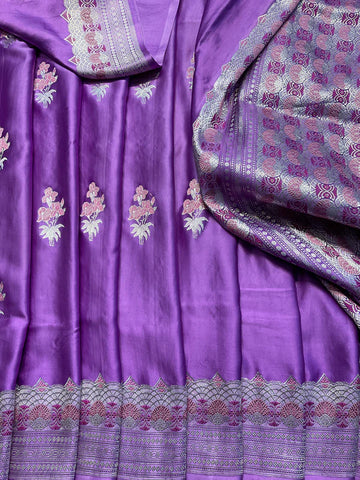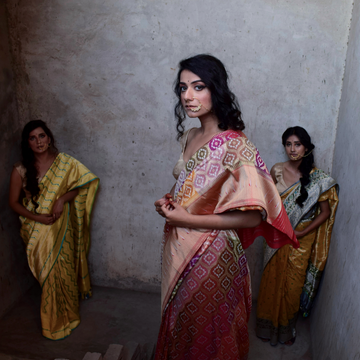
The queen of bollywood herself couldn't be more right. A saree is more than a piece of clothing. It is an expression of a person's emotions. Despite the age or gender of an individual, a saree can enhance anyone's beauty. You heard us correctly; every gender today appreciates a saree's power.
We can find more than 38 varieties of sarees in India. Each type's beauty is unique and a work of art in itself. Among the 38 varieties of sarees, the Banarasi sarees are regarded as mythical garments.
Colorful silks, glistening accents, and intricate patterns - rooted in tradition, infused with royal elegance - are the look of Banarasi weavings. Known to have been mentioned in the Mahabharata, these Indian Banarasi dupattas represent a hallowed slice of our history - that continues to be relevant even today.
Read the entire article to learn about the diva of sarees - Banarasi Sarees
Origin Of Banarasi Silk Sarees
Banarasi Sarees represent royalty!
In terms of artistry, Banarasi silk is unsurpassed. This fine craftsmanship was brought to India by the Mughals. In addition to glorifying weaving, they also promoted design. In their actions, they inspired a few artisans to master intricate weaving techniques. This is how the saree weaving art was born. Furthermore, Persian styles were added to Indian customary attire at that time.
Today's Banarasi Silks represent the fusion of two different cultures and the pioneering attitude of the Mughal dynasty. Not just in the Mughal dynasty, the artistic representation of the sarees can also be found in the Mahabharata.
There was a time when silk for Banarasi Sarees was imported from China, but nowadays, silk for Banarasi Sarees is supplied by the southern part of India.
Traditional Banarasi sarees are woven with silk according to a centuries-old art form. The culture of the artistry of Banarasi sarees has always been passed down from one generation to another.
Current Market of Hand-woven Banarasi Sarees
Despite today's modern advancements, sarees are still highly sought after. Silk and sarees from Banaras continue to reign supreme. For centuries, Varanasi has worked tirelessly to preserve its art and culture.
As far as the Banarasi saree is concerned, it still serves as a mark of royalty in the modern world, and for the contemporary woman.
The year 2009 was the year of triumph in keeping the Silk handloom saree alive. A significant threat to the art came from machine-driven industries and the new generation of weaving that did not require artisans.
The ruling of 2009 made clear that sarees from anywhere other than the six districts of Azamgarh, Jaunpur, Bhadohi, Mirzapur, Chandauli and Varanasi would be ineligible for sale under the prestigious name of Banarasi sari and silk.
Varieties of Banarasi Sarees
The Banarasi saree has four main varieties. However, silk Banarasi are the most popular. There are also variations such as Organza and Kora as well as "zari". Banarasi silks can also be categorized based on their design and decoration. The design determines each of these categories. Materials do not influence these categories.
- Sarees made of Katan stay and hold longer. As a silk saree, it has an exotic glow and radiance. For weddings or any other occasion, Katan is glamorous and elegant.
- To communicate the nature and weight of festivity, Jangla saris are designed with colorful silk threads. They are distinguished by their wild, spreading designs and flowing patterns.
- Colorful extra-weft silk yarn forms the outline of Tanchoi Sarees. There may be a kaleidoscopic effect associated with the decoration of these saris.
- The Zari brocade in Banarasi tissue sarees looks like golden cloth due to the design of the saris. Zari and silk are woven together to make them.
- Cutwork Sarees made of a plain texture after the floating threads have been removed. Saris of this type are sparkling and translucent.
- Dark blue silk saris known as Butidar saris are brocaded with silk, silver and gold in a distinctive way. It is also known as Ganga and Jamuna due to the dark shades of gold and the light shades of silver.
Why do people love banarasi sarees?
For centuries, Banarasi saris have been used to celebrate joyous occasions. A Banarasi Saree has a very royal appearance, which makes it popular among brides. The saris have a particular geometric pattern that is suitable for celebrations and joyous occasions.
HKV Benaras - the perfect destination to buy Banarasi Sarees
HKV Benaras is dedicated to making textile heritage more relevant, accessible, empathic, and creative. As part of our mission, we strive to bridge the gap between weavers, enterprises, consumers, and designers. Likewise, we aim for transparency in business, concise communication, and customer service excellence by eliminating an array of agents and distributors.
Few reasons why you should buy sarees from us are:
- Wide range of options
- Design expertise
- Customisable services
- Professional weavers & artists
- Dedication & promptness
- Transparent prices
Wrapping Up -
“Sarees can be passed on to the next generation and carry the same grace and elegance forward.” - Unknown
And a Banarasi silk saree is a cherished possession of exquisite workmanship and timeless appeal that will remain in a woman's wardrobe for many years to come.
If you are a saree lover, you should definitely have a banarasi saree in your wardrobe. And to the best quality hand-crafted banarasi sarees - welcome to HKV Benaras!


